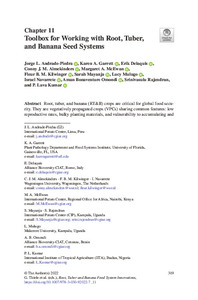| dc.contributor.author | Andrade-Piedra, J. |
| dc.contributor.author | Garrett, K.A. |
| dc.contributor.author | Delaquis, E. |
| dc.contributor.author | Almekinders, C.J. |
| dc.contributor.author | McEwan, M.A. |
| dc.contributor.author | Kilwinger, F.B. |
| dc.contributor.author | Mayanja, S. |
| dc.contributor.author | Mulugo, L. |
| dc.contributor.author | Navarrete, I. |
| dc.contributor.author | Omondi, A. |
| dc.contributor.author | Rajendran, S. |
| dc.contributor.author | Kumar, P.L. |
| dc.date.accessioned | 2022-05-23T11:48:36Z |
| dc.date.available | 2022-05-23T11:48:36Z |
| dc.date.issued | 2022 |
| dc.identifier.citation | Andrade-Piedra, J., Garrett, K.A., Delaquis, E., Almekinders, C.J., McEwan, M.A., Kilwinger, F.B., ... & Kumar, P.L. (2022). Toolbox for working with root, tuber, and banana seed systems. In M. Friedmann, H. Campos, V. Polar, and J.W. Bentley, Root, Tuber and Banana Food System Innovations. Cham: Springer, (p. 319-352). |
| dc.identifier.issn | 978-3-030-92021-0 |
| dc.identifier.uri | https://hdl.handle.net/20.500.12478/7474 |
| dc.description.abstract | Root, tuber, and banana (RT&B) crops are critical for global food security. They are vegetatively propagated crops (VPCs) sharing common features: low reproductive rates, bulky planting materials, and vulnerability to accumulating and spreading pathogens and pests through seed. These crops are difficult to breed, so new varieties may be released slowly relative to new emerging threats. VPC seed systems are complex and face several challenges: poor-quality seed of existing varieties, low adoption rates of improved varieties, and slow varietal turnover, limiting yield increases and farmers’ ability to adapt to new threats and opportunities. Addressing these challenges requires first identifying key knowledge gaps on seed systems to guide research for development in a holistic and coherent way. Working together across 10 crops and 26 countries in Africa, Asia, and Central and South America, the CGIAR seed systems research community has developed a “Toolbox for Working with Root, Tuber, and Banana Seed Systems,” which introduces 11 tools and a glossary to address four major gaps: (1) capturing the demand characteristics of different types of farmers; (2) identifying effective seed delivery pathways; (3) ensuring seed health and stopping the spread of disease; and (4) designing effective policies and regulations. We describe the toolbox and its creation and validation across 76 crop-and-country use cases, and illustrate how the tools, applied individually or in combination, are addressing the key knowledge gaps in RT&B seed systems. The tool developers are actively working to scale the toolbox, including identifying new partners and models for collaboration, developing new tools, and supporting new applications in VPCs, as well as for fruit, vegetable, grain, and pulse seed systems. |
| dc.description.sponsorship | CGIAR Fund Donors |
| dc.description.sponsorship | Netherlands Organization for Scientific Research |
| dc.description.sponsorship | Wageningen University and Research |
| dc.description.sponsorship | Bill & Melinda Gates Foundation |
| dc.format.extent | 319-352 |
| dc.language.iso | en |
| dc.publisher | Springer |
| dc.subject | Bananas |
| dc.subject | Seed Systems |
| dc.subject | Food Security |
| dc.subject | Planting Equipment |
| dc.subject | Root Crops |
| dc.subject | Multi-Stakeholder Processes |
| dc.title | Toolbox for working with root, tuber, and banana seed systems |
| dc.type | Book Chapter |
| cg.contributor.crp | Maize |
| cg.contributor.crp | Roots, Tubers and Bananas |
| cg.contributor.affiliation | International Potato Center |
| cg.contributor.affiliation | University of Florida |
| cg.contributor.affiliation | Alliance of Bioversity International and CIAT |
| cg.contributor.affiliation | Wageningen University and Research Centre |
| cg.contributor.affiliation | Makerere University |
| cg.contributor.affiliation | International Institute of Tropical Agriculture |
| cg.coverage.region | Africa |
| cg.coverage.region | Africa South of Sahara |
| cg.coverage.region | Central Africa |
| cg.coverage.region | East Africa |
| cg.coverage.region | West Africa |
| cg.coverage.country | Burkina Faso (Upper Volta) |
| cg.coverage.country | Cameroon |
| cg.coverage.country | Ethiopia |
| cg.coverage.country | Ghana |
| cg.coverage.country | Kenya |
| cg.coverage.country | Malawi |
| cg.coverage.country | Nigeria |
| cg.coverage.country | Zambia |
| cg.coverage.hub | Headquarters and Western Africa Hub |
| cg.researchtheme | Plant Production and Health |
| cg.identifier.bibtexciteid | ANDRADE-PIEDRA:2022 |
| cg.authorship.types | CGIAR and developing country institute |
| cg.iitasubject | Agronomy |
| cg.iitasubject | Banana |
| cg.iitasubject | Food Security |
| cg.iitasubject | Plant Breeding |
| cg.iitasubject | Plant Production |
| cg.notes | Published online: 07 Apr 2022 |
| cg.publicationplace | Cham, Switzerland |
| cg.accessibilitystatus | Open Access |
| cg.reviewstatus | Peer Review |
| cg.usagerightslicense | Creative Commons Attribution 4.0 (CC BY 0.0) |
| cg.targetaudience | Scientists |
| cg.identifier.doi | https://dx.doi.org/10.1007/978-3-030-92022-7_11 |
| cg.iitaauthor.identifier | P. Lava Kumar: 0000-0003-4388-6510 |
| cg.futureupdate.required | No |
| cg.contributor.acknowledgements | This research was undertaken as part of, and funded by, the CGIAR Research Program on Roots, Tubers and Bananas (RTB), with support from CGIAR Fund Donors, Netherlands Organization for Scientific Research (NWO)—WOTRO Science for Global Development, Wageningen University and Research (WUR), USDA NIFA grant 2015-51181-24257. Support is also appreciated from the CGIAR Research Program on Climate Change, Agriculture and Food Security (CCAFS). Bill & Melinda Gates Foundation grants OPP1019987 (SASHA), OPP121332 (SweetGAINS), and OPP1080975, USDA APHIS grant 11-8453-1483-CA, the USAID Feed the Future Haiti Appui à la Recherche et au Développement Agricole (AREA) project grant AID-OAA-A-15-00039, US NSF Grant EF-0525712 as part of the joint NSF-NIH Ecology of Infectious Disease program, US NSF Grant DEB-0516046, McKnight Foundation grant 16-275, and the University of Florida. |

